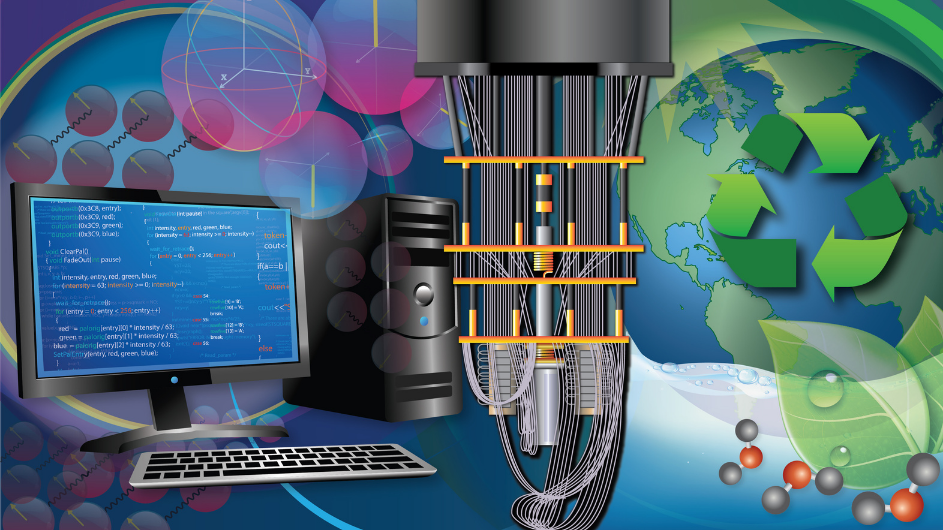Scientists at Columbia University and Google Quantum AI have formulated an algorithm that utilizes the most quantum bits up to now to measure ground state energy, a quantum mechanical system’s lowest-energy state. The innovation could help make it simpler to engineer new materials.
 An algorithm co-designed for classic and quantum computers may help research design materials for sustainability goals. Image Credit: Nicoletta Barolini.
An algorithm co-designed for classic and quantum computers may help research design materials for sustainability goals. Image Credit: Nicoletta Barolini.
Quantum computers are becoming bigger, but there are still some practical methods to exploit their additional computing power. To overcome this obstacle, scientists are developing algorithms to ease the evolution from traditional to quantum computers.
In a recent research article in the journal Nature, scientists reveal an algorithm that lessens the statistical errors, or noise, created by quantum bits (or qubits), in crunching chemistry equations.
Formulated by chemistry professor David Reichman and postdoc Joonho Lee from Columbia University, with scientists at Google Quantum AI, the algorithm utilizes up to 16 qubits on Sycamore, Google’s 53-qubit computer, to compute ground state energy, the lowermost energy state of a molecule.
These are the largest quantum chemistry calculations that have ever been done on a real quantum device.
David Reichman, Chemistry Professor, Columbia University
The capacity to accurately compute ground state energy will allow chemists to create new materials, stated Lee, who is also a visiting scientist at Google Quantum AI. The algorithm could be employed to engineer materials to accelerate both hydrolysis for creating clean energy and nitrogen fixation for farming, among other sustainability objectives, he explained.
The algorithm utilizes a quantum Monte Carlo, a system of approaches for measuring probabilities when there are a large amount of random, unidentified variables in action, comparable to a game of roulette.
Here, the scientists applied their algorithm to establish the ground state energy of three molecules: molecular nitrogen (N2), using 12 qubits; heliocide (H4), using eight qubits for the calculation; and solid diamond, using 16 qubits.
Ground state energy is affected by a number of unpredictabilities such as the number of electrons in a molecule, the direction in which they rotate, and the paths they follow as they circle a nucleus. This electronic energy is determined by the Schrodinger equation.
Cracking the equation on a traditional computer becomes exponentially tougher as molecules become bigger, although approaches for approximating the solution have rendered the process simpler. How quantum computers might avoid the exponential scaling issue has been an open challenge in the field.
In theory, quantum computers should be able to manage exponentially bigger and more difficult calculations, like those required to solve the Schrodinger equation, as the qubits that make them up exploit the quantum states.
In contrast to binary digits (bits) composed of ones and zeros, qubits are present in two states concurrently. Qubits, however, are delicate and susceptible to error: the greater the number of qubits used, the less precise the outcome.
Lee’s algorithm utilizes the integrated power of traditional and quantum computers to solve equations in chemistry more efficiently while reducing the quantum computer’s errors.
It’s the best of both worlds. We leveraged tools that we already had as well as tools that are considered state-of-the-art in quantum information science to refine quantum computational chemistry.
Joonho Lee, Postdoctoral Researcher, Columbia University
A traditional computer can manage the majority of Lee’s quantum Monte Carlo simulation. Sycamore is added in for the last, most computationally intricate step: the measurement of the overlap between a trial wave function — a guess at the mathematical depiction of the ground state energy that can be executed by the quantum computer — and a sample wave function, which is part of the statistical process of Monte Carlo.
This overlap offers a set of limits, called the boundary condition, to the Monte Carlo sampling, which guarantees the statistical competence of the calculation.
The previous record for solving ground state energy used 12 qubits and a technique known as the variational quantum eigensolver (VQE). But VQE overlooked the impacts of interacting electrons, a significant variable in computing ground state energy that Lee’s quantum Monte Carlo algorithm currently includes. Incorporating virtual correlation methods from standard computers could assist chemists in handling even bigger molecules, Lee said.
The hybrid traditional-quantum calculations in this new study were verified to be as precise as some of the best conventional approaches. This indicates that issues could be solved more precisely and/or swiftly using a quantum computer than without — a major milestone in the field of quantum computing.
Going forward, Lee and his colleagues will endeavor to tweak their algorithm to enhance it further, while engineers aim to develop better quantum hardware.
The feasibility of solving larger and more challenging chemical problems will only increase with time. This gives us hope that quantum technologies that are being developed will be practically useful.
Joonho Lee, Postdoctoral Researcher, Columbia University
Unbiased fermionic Quantum Monte Carlo with a Quantum computer - Quantum Summer Symposium 2021
Video Credit: Columbia University.
Journal Reference:
Huggins, W. J., et al. (2022) Unbiasing fermionic quantum Monte Carlo with a quantum computer. Nature. doi.org/10.1038/s41586-021-04351-z.